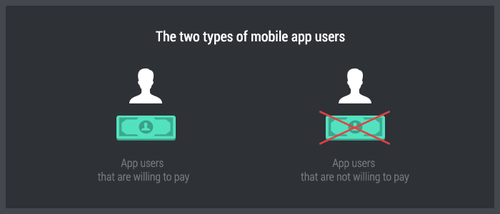Introduction to app monetization
Today we are launching a new column around mobile app monetization with several tips and insights on how to define an efficient mobile app monetization strategy based on the experience we gained so far by running our own monetization network…Pollfish. During the last two years and through our daily interaction with developers and the apps’ ecosystem we have seen a lot including several mistakes, bad and good practises and strategies .
Our main aim is to provide a better and deeper understanding to the app developer community, on different monetization techniques that exist out there and help developers adjust and evolve within the current mobile monetization landscape in a way that will increase their apps’ revenue.
The two types of mobile app users

One of the key factors when trying to understand mobile monetization landscape is the acknowledgement that there are two types of mobile app users out there:
- App users that are willing to pay (even 1 cent) – These users have no concerns on using their credit card or any other type of payment during an app’s lifecycle or even upfront. Developers can capitalize upon these users with different models like paid apps, in-app purchases, subscriptions and other. Understanding which of those models performs better in the context of a specific app will affect eventually the conversions achieved.
- App users that are not willing to pay (anything ever) – Some users will never pay for anything relevant to apps in general, or specifically for an app.
Within an app’s user base it is almost definite that these two types of users co-exist*. Developers can monetize upon both types. We will elaborate on this in the next paragraph. Identifying and implementing a monetization strategy based on these two type of users, can eventually increase app’s revenue.
*In general the volume of users of each type within an app varies depending on location, context of the app, platform and several other params that we will cover in future articles.
The two different revenue models for your app

There are two different revenue models that a developer can follow in order to make money from an app. These models are highly correlated with the two type of users identified in previous paragraph. Based on the acknowledgment of these two types, developer can use one or both of the following models:
- App user pays – Since such users exist within the user base of the app, defining a strategy that will help them convert at some point within the lifecycle of app usage, is a key point that will help increase app’s revenue. This model includes strategies like in-app purchases, paid apps, subscriptions and other formats.
- Mobile Monetization Network pays – Since the majority of the users of an app, are not willing to pay anything, developers should find different ways to capitalize upon them. This is something that can be achieved by partnering with different mobile monetization networks and by using different formats and models like banners, interstitials, offer walls, surveys, pay per installs and others.
To conclude, app developers should be able to acknowledge the existence of two types of users in their apps. Finding the right formula to combine and capitalize on both types of users by applying different revenue streams upon them is one of the key points to increase their apps’ revenue.
Do you want to distribute your survey? Pollfish offers you access to millions of targeted consumers to get survey responses from $1 per complete. Launch your survey today.
Global GSK Shingles Survey Insights
Original Insights,The Pollfish Blog
February 24, 2024
Shingles misconceptions: new global survey commissioned and funded by GSK highlights widespread…
B2B Sales Emails: Are they Effective or a Nuisance?
Original Insights,The Pollfish Blog
September 6, 2022
Are B2B sales emails a thorn in your side? Do they drive you crazy? Virtually all white-collar…
